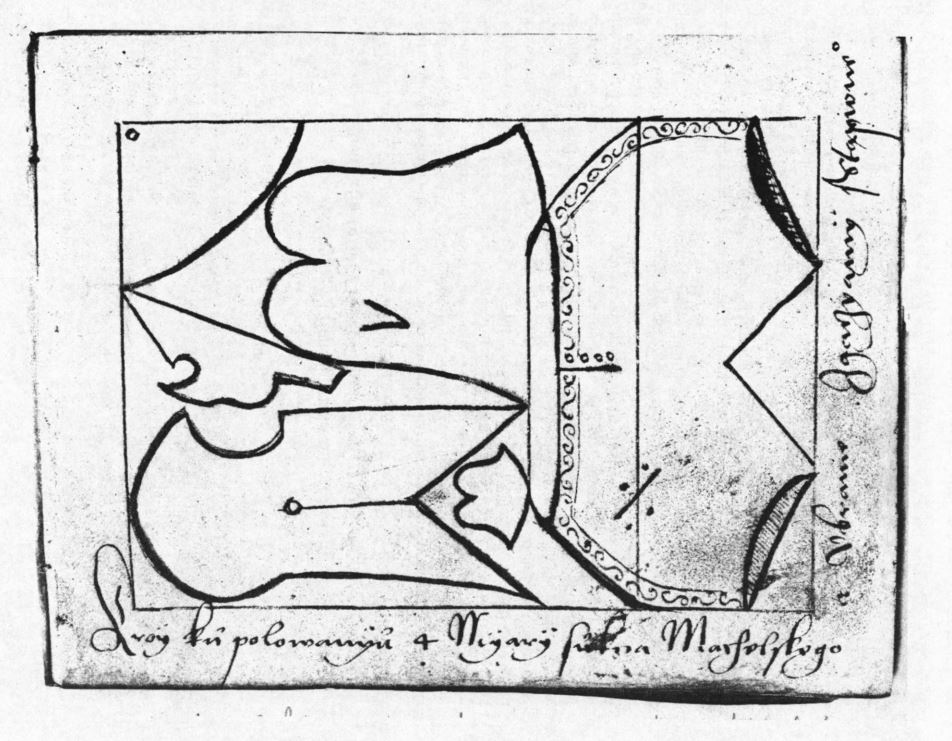1567-Breslau Polish cutting guide

Polish Tailor’s Cutting Guide from Germany, Breslau 1567, AC 1992.243.1.
https://collections.lacma.org/node/173816
Polish Tailor’s Cutting Guide
Germany, Breslau, mid-16th century
Ink on vellum
Costume Council Fund (AC1992.243.1)
Not currently on public view
One plate can be found in the following article:
Technika polskiego krawiectwa od XIV do pierwszej połowy XIX wieku
Series: http://bazhum.muzhp.pl/czasopismo/84/?idno=5494
Item: Technika polskiego krawiectwa od XIV do pierwszej połowy XIX wieku Irena Turnau
s. 201-223
Of note the text has this to say:
Natomiast niesłychanie interesujące świadectwo przekazywania informacji z cechu do cechu wynika z korespondencji pomiędzy krawcami Wrocławia i Bytomia zachowanej z 1567 r. Rękopis trafił do Los Angeles County Museum of Art. Anna Berdecka odczytała trudny polski tekst kopii przysłanej przez kuratora Edwarda Maedera w 1992 г., a ja zrobiłam uwagi fachowe. Będzie on zapewne wydany w Stanach Zjednoczonych. Można jednak tu poda ogólny opis najważniejszych informacji i wykrojów. Najpierw podano dane o ilości tkanin przeznaczonych na te stroje z podkreśleniem, że sukno „ma bicz stąpione”. Przysłano dziewię wykrojów. Na ornat przeznaczano 9 miar aksamitu, na dwie dalmatyki 16 miar tegoż, na płaszcz kapłański „czo w nym kadza” (kapa) 11 miar. Inne stroje były z sukna: kapłańska szata wymagała 9 miar lundyszu, „żeński płaszcz” tyle tej tkaniny; był to wykrój z półkola. Ubiór „ku polowaniu” wymagał cztery miary sukna machelskiego (czyli pochodzącego z Niderlandów), był to krój wamsa z krótkimi bufiastymi spodniami. „Formańska kythla” miała mie długoś 6 ćwierci i szyto j z ośmiu miar barchanu. „Kukla rajtarska” była obszernym, zachodzącym na plecy kapturem i wymagała pół miary lundyszu, albo miar sukna stępowanego. Ostatnia sztuka to „nastolka” czyli okrycie na siodło wykonane z czterech miar lundyszu. 25
25 Opisywany rękopis jest własnością Los Angeles County Museum of Art i mam nadzieję, że będzie tam w całości opublikowany wraz z opisywanymi wykrojami. Tu mogłam jedynie podać dane z własnych i dr Anny Berdeckiej zamówionych przez tę instytucję ustaleń.
An extremely interesting testimony of the transfer of information from guild to guild results from correspondence between tailors of Wrocław and Bytom preserved from 1567. The manuscript went to the Los Angeles County Museum of Art. Anna Berdecka read the difficult Polish text of the copy sent by curator Edward Maeder in 1992 and I made professional comments. It will probably be released in the United States. However, you can give a general description of the most important information and patterns here. First, data on the amount of fabrics intended for these outfits was given, emphasizing that the cloth “has a scuffed whip”. Nine patterns were sent. The chasuble was allocated 9 measures of velvet, two dalmatics 16 measures of the same, for the priest’s cloak “the foremost vat” (capa ) 11 measures Other costumes were made of cloth: the priest’s robe required 9 measures of lundsz, the “female coat” so much of the fabric; it was a semi-circle pattern. The garment “for hunting” required four measures of Machel cloth (that is, from the Netherlands), it was a Wams a cut with short puffy pants. “Forman’s kythla” was six-quarter long and sewn from eight measures of barchan. “Kukla rajtarska” was a voluminous hood overlapping the back and required half a measure of lundysz, or a measure of blunt cloth. The last piece is a “nastolka” or a saddle cover made of four measures of lundyszu.
25 This manuscript is owned by the Los Angeles County Museum of Art and I hope that it will be published in its entirety together with the described patterns. Here, I could only provide data from my own and Dr. Anna Berdecka’s findings ordered by this institution.
Hopefully interest in this document may help bring some more of these notes to the public.
Several sketches taken from a viewing of the book can be found at the following address:
http://www.renaissancetailor.com/research_polish.htm
Polish Tailor’s Cutting Guide from Germany, Breslau 1567, AC 1992.243.1.
This